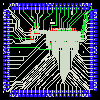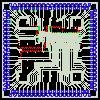
 The XicTools
Suite
The XicTools
SuiteWhiteley Research is developing the XicTools suite of integrated circuit design tools for Linux, Apple MacOS, and Microsoft Windows. Once sold as commercial products, the tools have transitioned to an open-source project, and are available free of charge for download and use. As open-source, it is anticipated that others will take on much of the future development, and with more exposure and users, the tools will evolve rapidly in a positive way. These tools are targeted for the design of small and medium scale digital and analog integrated circuits, primarily those using cutting-edge technologies where performance is paramount. However, the tools provide capibilities for working with very large layout files, even with a modest computer. The product line emphasizes flexibility and control in physical layout at the gate level. The XicTools suite currently consists of Xic, a graphical editor, and WRspice, a circuit simulator, plus numerous accessory programs and utilities. The XicTools can be built from source (which is recommended) or reasonably recent packages may be available from this web site. The programs can be built on Microsoft Windows, Apple MacOS, and about any version of Linux. |
 Why Choose Our Tools?
Why Choose Our Tools?
Great programs with unique features, plus they're free! That being said, these tools are not for everyone.
Whiteley Research can provide program customization,
consultation and contract development on technology file generation,
automation scripts, and other topics. Contact the company for
information and quotations.
The programs are in a constant state of improvement. New capability
is continually being added, bugs are fixed, operations are refined,
and efficiency is improved. While most users don't bother to install
every new release, users have the choice to update at their
convenience and according to their needs. The release notes are
available on this web site, and can be checked periodically for
announcements of new features that the user might find useful.
Major bugs are fixed immediately in the infrequent case that they are
found. Minor bugs are fixed in the scheduled release following their
discovery. What is "major" and "minor" to the user should be
communicated to Whiteley Research. If a former customer needs
a problem resolved, that problem will be resolved immediately.
|
|
Xic (More info here.) Xic is a graphical editor for physical layout and schematic capture. A main window and multiple pop-up windows provide editing capability for the electrical (schematic) and physical views of a cell. The WRspice simulator is called upon in a seamless manner to provide point-and-click simulation capability while in electrical mode. Schematics can be generated by extracting the netlist and device parameters from a physical layout, or from a SPICE listing provided by the user. SPICE and other netlist format output is available from the schematic, or directly from the physical layout. Interactive design rule checking is provided, as well as the more conventional batch-mode checking of physical layouts. Arbitrary angles are supported in physical geometry. Properties can be assigned to objects, and the property setting mechanism can be used to modify the geometry of objects. A powerful, non-lisp scripting language and interpreter is provided, with a debugging window that allows single stepping, breakpoint setting, and variable tracing to facilitate script development. A large collection of interface functions is provided, which enables the user to automate many tedious layout functions. Scripts can be executed through a "user" menu, by clicking on a label in the layout, or by clicking on an anchor in the HTML-based help viewer. Support is provided for parameterized cells (PCells) written in the native language, Python, or Tcl. This includes portable OpenAccess PCells using the Synopsys PyCell Studio. Xic has limited compatibility with Cadence Virtuoso and can read the Virtuoso/Ciranova display resource and technology files. Regular (non-PCell) OpenAccess cells can be loaded into Xic preserving most if not all of the technology attributes. Xic provides an extensive help system and on-line documentation. The system is intended to by customized by the user, as the file formats involved are simple and well documented. Scripts can be executed, files loaded into Xic for editing, or simulation runs initiated by WRspice by simply clicking anchors in the viewer. This provides a very powerful documentation tool to the Xic user. Xic provides netlist and parametric extraction and verification. Xic also provides a built-in extraction interface for the FasterCap program from FastFieldSolvers.com, and to other the open-source FastCap and FastHenry programs for three-dimensional R/L/C extraction. Customized versions of FastCap and FastHenry are now included in the XicTools suite. Xic can read and write files in GDSII, OASIS, CIF, CGX, and the native format. Any of these file types can be read into Xic without prior knowledge of what they contain - Xic will add layers, etc., as needed on-the-fly. A single, text-mode technology file provides all of the technology-specific information used by Xic. Most of the attributes in the technology file can be set from within Xic, and a new or updated technology file can be generated with a mouse click. Further, Xic can read and write Cadence Virtuoso ASCII technology and display resource files. Despite the high level of flexibility and power, Xic is designed to be intuitive and easy to learn. Short-cuts, macros, and scripts provide the potential for highly efficient and productive operation. See the Xic description for more information.
XicII
Xiv |
|
WRspice (More info here.) WRspice is an all-new SPICE-compatible simulator, written in C++. It is compatible with with the industry-standard SPICE syntax and many extensions used in other commercial SPICE simulators, including HSPICE. It offers a fully-featured plotting capability, extensive vector manipulation and post-processing functions, artificial-intelligence based automatic units tracking of vectors, and more. WRspice works seamlessly with the Xic graphical front-end for point-and-click schematic layout and simulation control, though WRspice is highly effective as a stand-alone tool. The built-in device library provides a fairly extensive collection of semiconductor devices, including the latest BSIM and BSIMSOI models from Berkeley. In addition to the built-in device models, support is provided for loadable device models. A compiler that will produce loadable modules from Verilog-A source is provided. A collection of open-source Verilog-A models is provided as examples, with pre-built modules available for use. WRspice includes A powerful graphics post-processor for output representation. A toolbar with multiple graphical input windows provides point and click operation of the many features and modes of the simulator. The simulator is network-aware, and can use parallel processing to speed certain types of analysis, such as operating range and Monte Carlo. A scripting language and interpreter provide programmability for automation. See the WRspice description for more information. |
|
Obtaining the
Software
The entire XicTools program suite is available free of charge for download and use. This is an open-source project. Click HERE for downloading and installation information.
Contact Whiteley Research for more information, and for
|